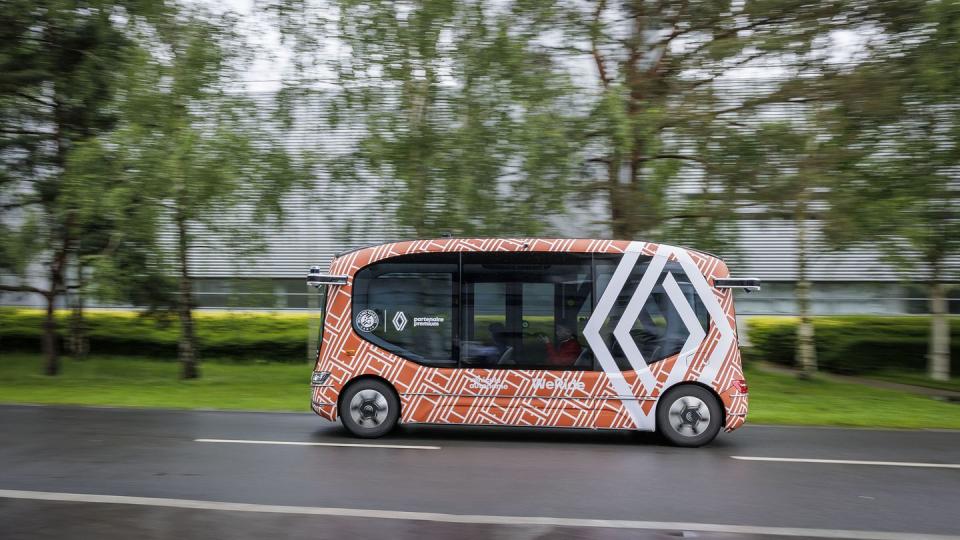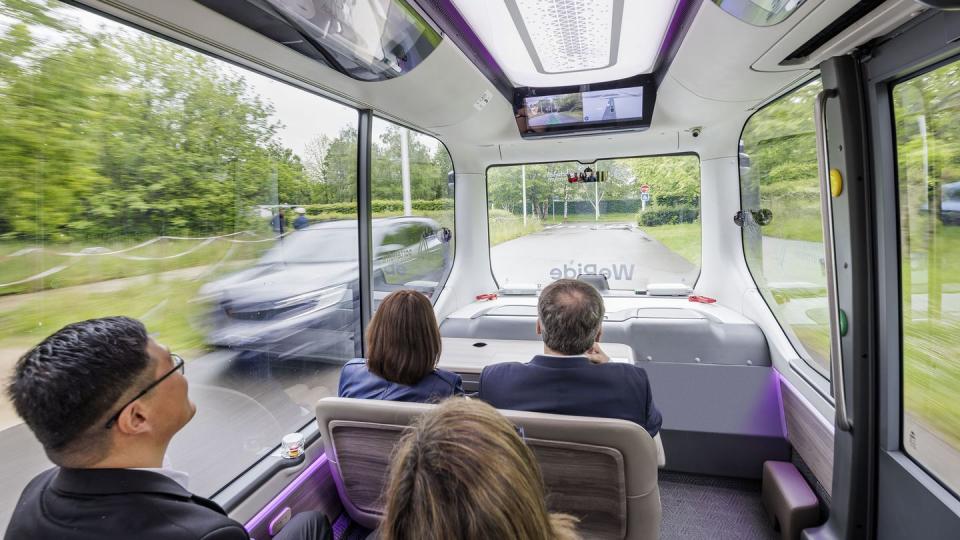This Carmaker Is Still Betting on Driverless Buses

Renault Group debuts a SAE Level 4 shuttle prototype in Paris, previewing an autonomous miniBus intended to go into production later in the decade.
The automaker sees relatively little potential for SAE Level 4 autonomy in privately owned vehicles, citing significant costs, as opposed to commercial shuttles.
Renault is optimistic about overcoming the costs of fleet-level autonomous operations, compared to professional human drivers.
Our gleaming autonomous future, as imagined nearly a decade ago, envisioned privately owned autonomous cars and autonomous buses alike, all zooming seamlessly in traffic, alongside the occasional Oldsmobile Bravada with a coughing exhaust looking like something from, well, another century.
Now, a decade later, we are seemingly close to this autonomous utopia with the limited rollouts of robotaxis on the West Coast, yet also still frustratingly far from it. Privately owned SAE Level 4 or 5 cars are nowhere to be seen, and neither are Level 4 shuttle buses that were promised to replace large, diesel-fume-belching behemoths.
But this doesn't mean that automakers have given up on the concept of commercializing smaller autonomous shuttles, able to carry about a dozen passengers, as a future mode of transport, perhaps paired with a ride-hailing app.
Renault is one of the automakers still betting on a Level 4 shuttle future, and its own vision of such a future will debut this month during the Roland-Garros tennis tournament in Paris, France.
Dubbed simply the miniBus and based on the Renault Master platform, the electric shuttle has been developed in partnership with autonomous tech firm WeRide.
Renault's wider take on our autonomous, electric future can perhaps be described as realistic, with the automaker voicing plenty of skepticism over the prospect of Level 4 making sense at the private vehicle level.
"There is a significant technological complexity gap between level L2 automation and level L3 autonomy, because the vehicle must be able to operate safely in complex environments with limited driver supervision," the automaker notes. "At this stage, the induced cost to be borne by customers, in relation to the driving benefits, would make demand insufficient or even anecdotal."

Renault's answer, one that has been seemingly previewed for over a decade by various concepts, is still a small shuttle for a dozen or so passengers. And the ultimate goal still appears to be ride-pooling.
The Level 4 vehicles that will be previewed in Paris in the next three weeks are a preview of what Renault Group plans to commercialize on a wider scale later in the decade, along with tech from Milla and EasyMile.
As with other developers, the automaker believes that the costs of the hardware and software could be paid for by the absence of a paid driver behind the wheel.
"The additional costs of robotization and automation could be offset by the absence of on-board operators. A simple remote supervision system will be required to operate a fleet of vehicles," Renault says confidently.
The business advantage, therefore, is to trade a larger number of in-person human drivers for a smaller number of remote human monitors.
Just how simple (or affordable) that remote supervision system will be in Renault's case remains to be seen. As we have discovered in the past couple of years, the number of people behind the scenes required for robotaxi operations even on a limited scale still outnumbers traditional human-driven taxi or ride-hailing operations, before we take all the computer and sensor hardware into account.
The automaker doesn't make any concrete predictions about the costs of remote supervision—a rarely mentioned aspect of Level 4 vehicles that has been glossed over in the recent rush of robotaxi operations stateside.

In practice, remote supervision has meant a high-tech center staffed with dozens of people watching over a fleet of Level 4 robotaxis or shuttles, and validating proposed solutions every time a vehicle encounters a problem that needs to be double-checked by a human.
Of course, not everything has to be solved during this trial roll-out of its Level 4 miniBuses, including the eventual business model. For now, this is a look at the tech that Renault has readied along with its partners in record time.
Moreover, Renault believes that the miniBuses could enter commercial service in a number of regions before the end of the decade.
As we've seen over the past decade, solving the technical aspects of SAE Level 4 driving may ultimately turn out to be the easy part of Level 4 autonomy. The business case behind it could prove to be the more difficult part.
Will autonomous shuttles eventually replace human-driven buses in the next few years, or is this technology still further away in time? Let us know what you think in the comments below.

 Yahoo Autos
Yahoo Autos 